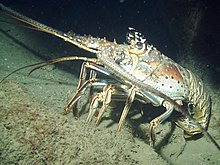Lobster-like
The division of living beings into systematics is a continuous subject of research. Different systematic classifications exist side by side and one after the other. The taxon treated here has become obsolete due to new research or is not part of the group systematics presented in the German-language Wikipedia.

The lobster-like (Palinura) were a suborder of the decapods (Decapoda). Because of their paraphyletic relationship, the families were incorporated into the sub-orders Achelata and Polychelida and the sub-order lobster-like dissolved.
description
They are large, elongated crabs, with a mostly flat carapace , with no or only a very small rostrum . The front legs are usually scissorless. In contrast, the last, fifth pair of striding legs often wears small scissors. The abdomen is strong and ends in a large tail fan, the rear edge of which is soft.
Most of the approx. 140 species are nocturnal and spend the day in caves and crevices. All lobsters feed on carrion , all kinds of invertebrates and algae. There are lobsters in all oceans. The 40 species of the Polychelidae family live in the deep sea up to a depth of 4500 meters. Many species are caught by humans and are considered delicacies.
Systematics
The langoustines were formerly divided into two superfamilies with five families:
- Lobsters (Palinura)
- Eryonoidea De Haan, 1841
- Eryonidae De Haan, 1841
- Polychelidae Wood-Mason, 1874
- Palinuroidea Latreille, 1802
- Crawfish (Palinuridae) Latreille, 1802
- Slippery shrimp (Scyllaridae) Latreille, 1825
- Fur lobsters (Synaxidae) Bate, 1881
- Eryonoidea De Haan, 1841
Lobsters and slippery lobsters were assigned to the suborder Achelata mainly because of the lack of claws on the first four pairs of striding legs and based on molecular genetic analysis . According to this analysis, the genera of the furry lobster are part of the lobster family and thus lose their family status. Polychelidae and Eryonidae became families of the Polychelida .
swell
- Helmut Debelius : Cancer guide: prawns, crabs, lobsters, lobsters, mantis shrimp, worldwide. Jahr-Verlag, Hamburg 2000, ISBN 3-86132-504-7 .
- H. Füller, H.-E. Gruner, G. Hartwich, R. Kilias, M. Moritz: Urania Tierreich, Invertebrates 2 (Annelida to Chaetognatha) . Urania-Verlag, Berlin 1994, ISBN 3-332-00502-2 .
- Joel W. Martin, George E. Davis: An Updated Classification of the Recent Crustacea . Ed .: Natural History Museum of Los Angeles (= Science Series . Volume 39 ). 2001, p. 124 ( nhm.org [PDF; 756 kB ; accessed on February 18, 2012]).
Individual evidence
- ↑ Sammy De Grave, N. Dean Pentcheff, Shane T. Ahyong et al: A classification of living and fossil genera of decapod crustaceans . In: Raffles Bulletin of Zoology . Supplement No. 21, 2009, p. 1–109 ( edu.sg [PDF; 7,8 MB ; accessed on March 14, 2012]).
- ^ Gerhard Scholtz, Stefan Richter: Phylogenetic systematics of the reptantian Decapoda (Crustacea, Malacostraca) . In: Zoological Journal of the Linnean Society . tape 113 , 1995, pp. 289–328 ( nhm.org [PDF; 2.7 MB ; accessed on March 14, 2012]).
- ↑ Ferran Paleroa, Keith A. Crandallb, Pere Abellóc, Enrique Macphersond, Marta Pascuala: Phylogenetic relationships between spiny, slipper and coral lobsters (Crustacea, Decapoda, Achelata) . In: Molecular Phylogenetics and Evolution . tape 50 , no. 1 , 2009, p. 152–162 , doi : 10.1016 / j.ympev.2008.10.003 .
